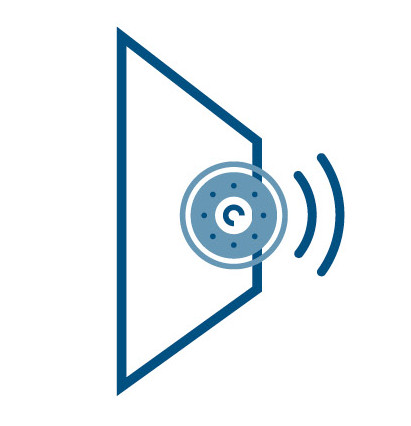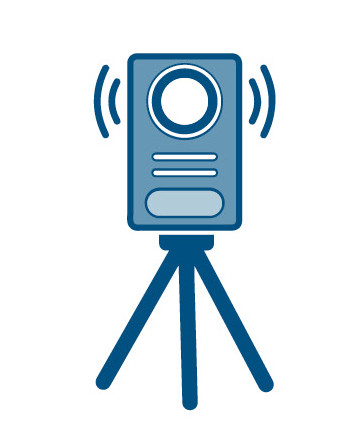Introduction
NPSA runs various functional evaluation schemes for perimeter intrusion detection products. This page describes the schemes and the process that manufacturers should follow for product submission. On successfully passing the evaluation, products will be awarded a specific grade (known as a CLASS rating) and listed in the NPSA Catalogue of Security Equipment (CSE).
All evaluations are funded by the manufacturer and specific costs will be determined by the test lab performing the evaluation, based on the scope and complexity of the product being evaluated.
In any given evaluation against the various PIDS standards, it is unlikely that products can be tested in complete isolation. As such products supplied for an evaluation will fall under two categories, “core” and “peripheral”.
Components that when connected together provide the functionality required by that specific standard and are therefore examined in detail during the evaluation and form the “assured product”.
Components that the core product will be connected to in a deployment and that generate data and/or take actions as determined by the core product.
Typically, there will be a choice of peripheral components available (from either the manufacturer submitting or other manufacturers) and one of these choices will be used to demonstrate and test the functionality of the core product during the evaluation. The manufacturer is expected to provide peripheral devices that demonstrate the functionality and security of the core product and that meet any requirements and dependencies identified in the standard.
With this said, some PIDS systems may only have core components and no peripheral elements to their systems.
Evaluation Schemes Status
NPSA currently have functional standards for the following product areas:
|
Product |
Scheme Status |
Current Standard |
|
Barrier Mounted PIDS |
OPEN TO SUBMISSION |
Barrier Mounted PIDS Standard V6.0 |
|
Ground Based PIDS |
CLOSED TO SUBMISSION |
Under review |
|
Free Standing PIDS |
CLOSED TO SUBMISSION |
Under review |
|
Rapidly Deployable PIDS |
CLOSED TO SUBMISSION |
Under review |
|
Wide Area Detection PIDS |
CLOSED TO SUBMISSION |
Under review |
Standards can be requested by completing the Product Submission process.
Evaluation Schemes Detail
Barrier Mounted PIDS
 NPSA classes systems installed on a permanent basis on either the fabric or posts of a barrier as barrier mounted PIDS. Evaluation of this type of PIDS is designed to assure the systems performance when deployed ‘in the field’ i.e. installed on a type of barrier typically of a commercial setting. Therefore, the PIDS manufacturer will need to supply and install a barrier ahead of the evaluation. Evaluation typically takes eight to nine months post manufacturer commissioning.
NPSA classes systems installed on a permanent basis on either the fabric or posts of a barrier as barrier mounted PIDS. Evaluation of this type of PIDS is designed to assure the systems performance when deployed ‘in the field’ i.e. installed on a type of barrier typically of a commercial setting. Therefore, the PIDS manufacturer will need to supply and install a barrier ahead of the evaluation. Evaluation typically takes eight to nine months post manufacturer commissioning.
Ground Based PIDS
 Systems installed on a permanent basis below ground level are classed as ground based PIDS. A ground based PIDS evaluation is designed to assure the systems performance in either a sterile zone or open area setting when buried in media it would typically be installed in. Evaluation typically takes 8-9 months post manufacturer commissioning.
Systems installed on a permanent basis below ground level are classed as ground based PIDS. A ground based PIDS evaluation is designed to assure the systems performance in either a sterile zone or open area setting when buried in media it would typically be installed in. Evaluation typically takes 8-9 months post manufacturer commissioning.
Rapidly Deployable PIDS
 NPSA consider ‘rapidly deployable’ PIDS to cover a broad spectrum of systems, ranging from those that resemble permanently installed PIDS that can be hard-wired into alarm relays - to systems that are designed with compactness, portability, robustness and, potentially, covert operation in mind. The differentiating factors from permanently installed PIDS are the speed and ease of deployment and the utilization of batteries as a power source. These factors are components of the evaluation process. If a barrier is required for deployment of the PIDS, the manufacturer will need to supply and install one before evaluation can commence.
NPSA consider ‘rapidly deployable’ PIDS to cover a broad spectrum of systems, ranging from those that resemble permanently installed PIDS that can be hard-wired into alarm relays - to systems that are designed with compactness, portability, robustness and, potentially, covert operation in mind. The differentiating factors from permanently installed PIDS are the speed and ease of deployment and the utilization of batteries as a power source. These factors are components of the evaluation process. If a barrier is required for deployment of the PIDS, the manufacturer will need to supply and install one before evaluation can commence.
Free Standing PIDS
 A Free Standing PIDS is an above ground system that falls into two categories – passive and active. NPSA evaluates these systems for use in both sterile and non-sterile zones. Systems that are found to be suitable for open areas will automatically be suitable for sterile zones but not vice versa. Trials take place in a narrow area designed to simulate a deployment on a perimeter in either a sterile or open area. Trials typically take eight to nine months to complete.
A Free Standing PIDS is an above ground system that falls into two categories – passive and active. NPSA evaluates these systems for use in both sterile and non-sterile zones. Systems that are found to be suitable for open areas will automatically be suitable for sterile zones but not vice versa. Trials take place in a narrow area designed to simulate a deployment on a perimeter in either a sterile or open area. Trials typically take eight to nine months to complete.
Wide Area Detection System
 Systems installed above ground and intended for use on a permanent basis to protect a wide arc or area (as opposed to a linear detection zone associated with a boundary) are referred to as ‘Wide Area Detection System (WADS)’. NPSA will evaluate a WADS in an uncluttered and cluttered area as it is more representative of a real deployment. Trials typically take eight to nine months to complete.
Systems installed above ground and intended for use on a permanent basis to protect a wide arc or area (as opposed to a linear detection zone associated with a boundary) are referred to as ‘Wide Area Detection System (WADS)’. NPSA will evaluate a WADS in an uncluttered and cluttered area as it is more representative of a real deployment. Trials typically take eight to nine months to complete.
Evaluation Schemes Scope
All core modalities of PIDS, irrespective of the technology used, require a sensor to perform in a certain way. All evaluations use consistent methodology during attack trials to determine the Detection Rate (DR) and during false alarm trials to determine the False Alarm Rate (FAR). Trials cover a period of 250-254 days subject to whether the DR trials are carried out in parallel, before or after the FAR trial with the exception of ‘Rapidly Deployable PIDS’.
Evaluations do not consider attacks against Control and Indicating Equipment (CIE). CIE can include equipment such as control panels, power supply, and ancillary control equipment (ACE).
Evaluation Schemes Grading
Based on the results of an evaluation the product will be awarded a CLASS level.
CLASS levels are not publicly advertised but are available to Government and CNI sites.
There are three NPSA-defined classes: CLASS 1,2 and 3. In its simplest form, the CLASS grading is awarded based on its resistance to attackers of different abilities as below.
An attacker with basic knowledge. They are looking to undertake their attack without any real concern for detection using rudimentary methods to defeat the product.
An attacker with technical product knowledge. They are motivated to defeat the product and to avoid detection. They will also use more sophisticated equipment to undertake their attack.
A highly skilled attacker specifically trained to undertake the attack. They have access to specialist tools, training facilities and knowledge; they are very well resourced.
If a manufacturer wishes to submit a product for an assurance evaluation the following steps should be followed:
 |
The manufacturer reads the requirements of the appropriate standard (using relevant technical personnel) to ensure its relevance to the product. Standards can be requested using the CSE submission process form using the relevant category. |
 |
The manufacturer contacts an authorised NPSA test lab (listed below). The test lab and manufacturer discuss the evaluation process and the standard's requirement. |
 |
The manufacturer completes an NPSA Self-Funded Manufacturer Agreement. This can be requested from NPSA via the test lab. This form needs to be completed and signed by the manufacturer and returned to the test lab who will forward to NPSA. |
 |
Once necessary financial and legal agreements are in place between the manufacturer and the test lab, the formal evaluation will proceed. |
 |
The manufacturer installs and configures the core product and any associated peripheral components at the test lab's location of choice where it is commissioned appropriately. Training of test lab staff to a suitable level is required. |
 |
The product is evaluated by the test lab. The test lab may ask specific questions to the manufacturer about the product during the evaluation period. The test lab issues a detailed report to NPSA for review and a panel comprising of test lab and NPSA personnel is convened to discuss the findings and issue the evaluation result. |
 |
Should a product pass the evaluation, the manufacturer will be notified of the result by letter and advised on future use of the NPSA trademark. The product will then be published in the CSE. |
 |
Should a product fail to achieve a CLASS rating, the manufacturer will be notified of the result by letter and a summary report will be issued by the test lab containing findings and recommendations on required areas of improvement. |
 |
NPSA's decision is final and non-contestable. Manufacturers will be encouraged to fix any necessary adverse findings and to resubmit the product for partial or full evaluation. |
Post Evaluation Requirements
A successful evaluation will assure a product for two years. The manufacturer will be expected to engage a Test Lab of the manufacturer's choice before the two year anniversary of the issuing of the NPSA Pass Letter; to undergo a lightweight renewal process. This will be repeated every two years until the 12th year where NPSA will require the manufacturer to undergo a subset of the original detection rate (DR) trials.
 |
Approximately four to six months prior to expiry, the manufacturer will engage with any of the NPSA approved test labs. This process will be funded by the manufacturer. |
 |
The manufacturer provides a change log of the product since the initial evaluation to the test lab. |
 |
A two day (indicative) impact assessment is carried out by the test lab comparing changes submitted by the manufacturer to the current published standard. |
 |
A gap analysis to identify any fundamental changes to the product and/or development processes compared to the initial evaluation is performed by the test lab. |
 |
A recommendation of what type of intervention (e.g. minor document review, partial re-evaluation or full re-evaluation) is provided by the test lab to NPSA. |
 |
NPSA panel will review the test lab report and findings and will be reported back to the manufacturer by the test lab. |
 |
If no significant issues are reported, NPSA will write to the manufacturer confirming the trademark will be awarded for a further two years. If significant issues of concern are reported, a partial (or full) re-assessment may be required. At 12 years from the initial pass the product is required to undergo a full reassessment. |
NPSA Authorised Test Labs
|
Evaluation Scheme |
Test Lab |
Test Lab Contacts |
|
Barrier Mounted PIDS |
Millbrook |
|
|
Ground Based PIDS |
Not open for submission |
Not available |
|
Free Standing PIDS |
Not open for submission |
Not available |
|
Rapidly Deployable PIDS |
Not open for submission |
Not available |
|
Wide Area Detection PIDS |
Not open for submission |
Not available |